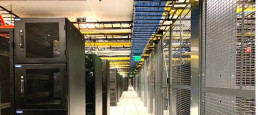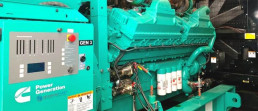There are many considerations when selecting a data center.
While overall security of a data center, capacity, and scalability are likely at the top of your list, the power that brings a data center to life and keeps you up and running is an essential, but often overlooked component.
No matter your online presence, electricity is the backbone. Understanding how power relates to data center design is critical for both continuity and security.
Learning more about the role of power in the data center, how things work and the trends you should be aware of will help you make the best choices for your organization.

Data Center Energy Basics: Electricity 101
Without power, even the most advanced and powerful network is merely a pile of metal scrap. No matter how sophisticated your setup is, unless it is getting and using power efficiently, you could be missing out. Here are some basic terms to know when it comes to data center power.
AC and DC Power: You have two options when it comes to powering your data center — or any other device that uses electricity. AC power or Alternating Current power is the power you think of when you plug in a device, appliance or tool. Currents of 120 or 240 volts power on demand — simply plug your item into the nearest outlet, and you are ready to go. The “alternating” part of this type of power comes from the way it is delivered; it can change direction multiple times in a single minute to optimize performance and efficiency.
DC power or Direct Current power relies on batteries; your laptop, your phone, and other devices that can be connected to an AC outlet to charge and then run off of the battery. A direct current runs in only one direction and is more reliable than Alternating current, making it an ideal way to avoid. While the majority of colocation data centers rely on alternating current for power, more and more organizations are incorporating DC power and a combination of the two types to enhance energy efficiency and reduce downtime.
Power usage effectiveness, or PUE, is a figure that represents the ratio of power available to a data center vs. the power consumed by IT equipment. PUE is an expression of efficiency; this number can reveal how much power your servers themselves are using and how much is being used on non-server/non-IT tasks. A high PUE means that you could be running more efficiently than you are and that you may be using too much power. A low PUE means you are running optimally and that you have little waste.
Determine the PUE of your center by dividing the total energy consumed by your entire facility by the energy consumed by your IT equipment. The resulting figure is your PUE, which will ideally be as close to 1 as possible. Why so low? Lower ratios mean that you are using most of your energy to get the actual job done – -not to power the office, lights and other support items.
Data Center Efficiency Metrics
Electricity is measured in specific terms; each is detailed below and will help you understand what your organization needs to meet your power and energy efficiency goals.
- Amperes: Also called “amps,” this is the actual moving electricity that is running through your wires and to your servers and equipment. Each of your devices, from your workstations to your laptops and servers, uses a specific amount of amps to run.
- Volts: The power that “pushes” the electricity from the source and to your outlets and devices; actual voltage depends on location, the choices made during construction and setup and even the manufacturer of the piece you are using. Both batteries and outlets provide power that can be measured in volts — from a little as 1.5 volts for a small battery to 110 or 220 in a typical office or home outlet.
- Watts: The actual amount of power your server or device uses is measured in watts. This figure goes up the more you use your equipment; it also rises when your equipment multi-tasks or solves complex problems. An ASIC or GPU device mining cryptocurrency or performing complex tasks will use more your data center server or one of your workstations, due to the work it is performing.
The power that is available to your data center, the way that energy is used, and even the amount of electricity your pieces consume all have an impact on your costs, efficiency and even productivity.
Power in the Data Center
All those watts and volts need to go somewhere, and the typical data center has a variety of needs; some of these are more obvious than others. While each organization is different, a data center needs the following to run efficiently:
- Servers: The actual units doing the work, storing the data and providing support for your brand, racks and other related items.
- Cooling: Servers and related equipment generate heat; you need to power equipment that will keep your hardware cool to prevent damage and extend its life.
- Inverters: You won’t notice these until you need them. Inverters store power and launch when the AC power source is disrupted. This prevents downtime, data loss, and interruption of service.
- Support: Someone has to look after the servers, ensure the location is physically secure and respond to problems. Any support staff onsite needs the typical power and electricity support of an office. Count on lights, workstations, HVAC and more for your on-site team.
- Security: Alarms, physical security that prevents others from accessing your center or equipment.

Understanding Power Usage Effectiveness (PUE)
Understanding how energy is measured and deployed in the typical data center can help you make changes that will increase your efficiency and lower your costs. From a basic understanding of how electricity is measured to the impact that non-IT energy consumption has on your bottom line.
Power usage effectiveness, or PUE, is a figure that represents the ratio of power available to a data center vs. the power consumed by IT equipment. PUE is an expression of efficiency; this number can reveal how much power your servers themselves are using and how much is being used on non-server/non-IT tasks. A high PUE means that you could be running more efficiently than you are and that you may be using too much power for your data center. A low PUE means you are running optimally and that you have little waste.
Determine the PUE of your center by dividing the total energy consumed by your entire facility by the energy consumed by your IT equipment. The resulting figure is your PUE, which will ideally be as close to 1 as possible. Why so low? Lower ratios mean that you are using most of your energy to get the actual job done – -not to power the office, lights, and other support items.
An ideal target value for an existing data center is 1.5 or less (new centers should aim for 1.4 or less, according to Federal CIO targets and benchmarks. A PUE of 2.0 or higher indicates a need for review. There are likely areas of inefficiency that are adding to costs and not beneficial.
In Closing, Considering Data Center Power Design
This information allows you to make informed decisions when choosing a data center. The best provider ensures that the power infrastructure is in place to guarantee the highest uptime possible. Learn more about our state of the art data centers worldwide.